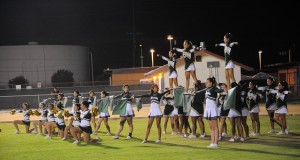The sounds of uproarious applause and upbeat cheer music create a festive atmosphere as Senior Irene Shinn flies through the air and then falls gracefully into a nest of the arms of her smiling teammates.
In cheer, just like sports such as football or soccer, there are different positions that the girls can take on: the bases, the backspots and last but not least, the flyers. The bases and back spots provide the foundation at the bottom of the formations, while the flyers are the ones who are flipped into the air.
“I trust my bases and backdrops 110% because they really know what they’re doing. One of my backdrops is a four-year member so she’s very experienced,” Shinn said. “She helps me become a better flyer. Even though she’s not a flyer, she knows what I should do to make it easier for me and her.”
Although there is no formal tryout for the cheer roles, characteristics such as height and weight may affect the selection process of a certain position. For example, most flyers are generally lighter and shorter than their other counterparts.
This year, there are five flyers in total: Freshman Mercylia Susantono, Sophomore Naomi Valbuena, Juniors Samantha Peebles and Emily Stoker and Senior Shinn. Valbuena is the only returning flyer.
“The best part about being a flyer is that you’re representing the whole cheer,” Shinn said. “Since you’re at the center, it’s a lot of pressure, but I also think that’s a lot of fun.”
Though the flyers’ moments in the air may seem effortless, it can be extremely demanding because they must stay calm and still so that their teammates can catch them correctly. Shinn stresses that flyers may be light, but if they cannot hold their own weight, they could end up weighing twice as much when they fall.
“When I first started, I was really scared that I was going to fall,” Shinn said. “Now, I just don’t really feel anything, rather, I just focus more on my body and keeping it tight and steady.”
Flyers and their bases and backdrops must develop a strong sense of faith in each other’s abilities in order to make sure a routine goes right. Teambuilding exercises and outside bonding all contribute to the adaptation of this trust, such as falling exercises and a cheerleading training camp over the summer that was led by a professional cheerleading scout. Even with these precautions, injuries are common, especially for flyers.
“A sprained ankle may take a couple weeks to heal,” Valbuena said. “We’re kind of pushed to get back to cheering, so if you feel comfortable enough to keep on stunting, then you can. We’re encouraged to come back right away.”
Despite the setbacks, the girls continue to enjoy cheer. After overcoming the fears of falling, the flyers have learned to truly trust their teammates.

